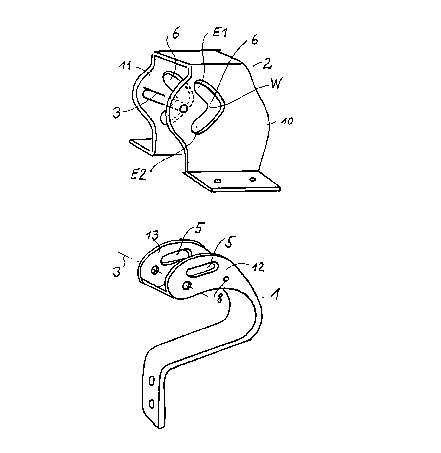Some of the information on this Web page has been provided by external sources. The Government of Canada is not responsible for the accuracy, reliability or currency of the information supplied by external sources. Users wishing to rely upon this information should consult directly with the source of the information. Content provided by external sources is not subject to official languages, privacy and accessibility requirements.
Any discrepancies in the text and image of the Claims and Abstract are due to differing posting times. Text of the Claims and Abstract are posted:
| (12) Patent Application: | (11) CA 2316573 |
|---|---|
| (54) English Title: | FOLDING HINGE |
| (54) French Title: | ARTICULATION PIVOTANTE |
| Status: | Deemed Abandoned and Beyond the Period of Reinstatement - Pending Response to Notice of Disregarded Communication |
| (51) International Patent Classification (IPC): |
|
|---|---|
| (72) Inventors : |
|
| (73) Owners : |
|
| (71) Applicants : |
|
| (74) Agent: | OSLER, HOSKIN & HARCOURT LLP |
| (74) Associate agent: | |
| (45) Issued: | |
| (22) Filed Date: | 2000-08-22 |
| (41) Open to Public Inspection: | 2001-02-24 |
| Examination requested: | 2005-08-18 |
| Availability of licence: | N/A |
| Dedicated to the Public: | N/A |
| (25) Language of filing: | English |
| Patent Cooperation Treaty (PCT): | No |
|---|
| (30) Application Priority Data: | ||||||
|---|---|---|---|---|---|---|
|
A pivoting hinge joint consists of a stationary part and a moveable part,
joined by
a pivoting hinge joint. The joint includes a non-straight guideway within the
stationary part, defining two end stop positions at either end with a turning
point
between the two ends. A guided member is held in one of the two end stop
positions by a spring, such that motion of the pivoting arm is guided by the
guideway and the spring provides resistance against the movement of the
guiding
piece between an end stop position and the turning point, whiling biassing the
guided member from the turning point towards either of the end stop positions.
Note: Claims are shown in the official language in which they were submitted.
Note: Descriptions are shown in the official language in which they were submitted.

2024-08-01:As part of the Next Generation Patents (NGP) transition, the Canadian Patents Database (CPD) now contains a more detailed Event History, which replicates the Event Log of our new back-office solution.
Please note that "Inactive:" events refers to events no longer in use in our new back-office solution.
For a clearer understanding of the status of the application/patent presented on this page, the site Disclaimer , as well as the definitions for Patent , Event History , Maintenance Fee and Payment History should be consulted.
| Description | Date |
|---|---|
| Inactive: Agents merged | 2013-10-29 |
| Application Not Reinstated by Deadline | 2007-08-22 |
| Time Limit for Reversal Expired | 2007-08-22 |
| Deemed Abandoned - Failure to Respond to Maintenance Fee Notice | 2006-08-22 |
| Inactive: IPC from MCD | 2006-03-12 |
| Inactive: IPC from MCD | 2006-03-12 |
| Inactive: IPC from MCD | 2006-03-12 |
| Amendment Received - Voluntary Amendment | 2006-02-24 |
| Amendment Received - Voluntary Amendment | 2005-10-05 |
| Letter Sent | 2005-09-16 |
| All Requirements for Examination Determined Compliant | 2005-08-18 |
| Request for Examination Received | 2005-08-18 |
| Request for Examination Requirements Determined Compliant | 2005-08-18 |
| Inactive: Entity size changed | 2004-09-10 |
| Letter Sent | 2001-04-17 |
| Inactive: Single transfer | 2001-03-23 |
| Application Published (Open to Public Inspection) | 2001-02-24 |
| Inactive: Cover page published | 2001-02-23 |
| Inactive: First IPC assigned | 2000-11-07 |
| Inactive: Courtesy letter - Evidence | 2000-09-19 |
| Inactive: Filing certificate - No RFE (English) | 2000-09-13 |
| Inactive: Applicant deleted | 2000-09-12 |
| Application Received - Regular National | 2000-09-12 |
| Abandonment Date | Reason | Reinstatement Date |
|---|---|---|
| 2006-08-22 |
The last payment was received on 2005-08-18
Note : If the full payment has not been received on or before the date indicated, a further fee may be required which may be one of the following
Patent fees are adjusted on the 1st of January every year. The amounts above are the current amounts if received by December 31 of the current year.
Please refer to the CIPO
Patent Fees
web page to see all current fee amounts.
| Fee Type | Anniversary Year | Due Date | Paid Date |
|---|---|---|---|
| Application fee - small | 2000-08-22 | ||
| Registration of a document | 2001-03-23 | ||
| MF (application, 2nd anniv.) - small | 02 | 2002-08-22 | 2002-08-01 |
| MF (application, 3rd anniv.) - small | 03 | 2003-08-22 | 2003-07-30 |
| MF (application, 4th anniv.) - standard | 04 | 2004-08-23 | 2004-08-18 |
| Request for examination - standard | 2005-08-18 | ||
| MF (application, 5th anniv.) - standard | 05 | 2005-08-22 | 2005-08-18 |
Note: Records showing the ownership history in alphabetical order.
| Current Owners on Record |
|---|
| SCHWARZ VERBINDUNGS-SYSTEME GMBH |
| Past Owners on Record |
|---|
| HELMUT SCHWARZ |